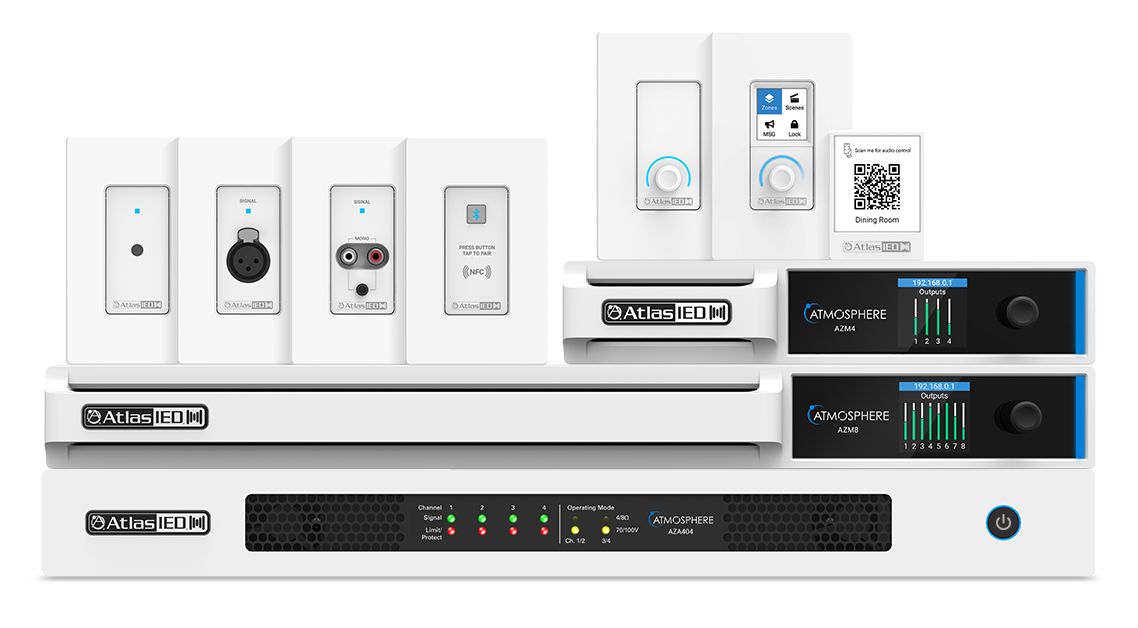Integrated Amplification Simplifies Installations with Minimal Audio Inputs
Many venues are turning to solutions with internal audio processing capabilities to reduce the need for separate components for signal conditioning, audio processing, and amplification.

It is often said that simpler is always better – and for venues and spaces with minimal audio input requirements, that may be the case. Many are turning to solutions with internal audio processing capabilities, which decrease the footprint of their network while reducing the need for separate components for signal conditioning, audio processing, and amplification.

“With design advancements, almost all amplifiers these days have some level of audio processing built in,” said Sanjay Kulkarni, senior director of amplifier product development at U.S.-based audio manufacturer QSC. “This audio processing includes signal conditioning, loudspeaker voicing, loudspeaker monitoring – for shorts, opens, impedance changes, etc. – as well as loudspeaker protection which happens within the amplifier, as they are directly attached to the speaker.”
With the pandemic changing the way spaces are designed, there has been increased usage of products with integrated amplification, including powered ceiling speakers and surface-mounted speakers. These PoE-powered speakers are excellent examples of the benefit of integrated amplification and receive audio via a network audio transport.
“In this example, the amplifier can be ‘tuned’ to the specific drivers within the speaker to achieve both higher fidelity and higher SPL than is possible via traditional speakers without built-in amplification,” said Tom Lureman, director of engineering and product management with commercial audio solutions provider AtlasIED. “In some cases, the drivers in the speaker can be bi-amped, further improving sound quality while eliminating the need for a passive internal crossover.”

According to some manufacturers, integrated amplification is one of the biggest processing and amplification trends within the residential and commercial audio markets, as seen through the popularity of products like Bluetooth speakers and portable PA speakers. When discussing their needs around audio processing and amplification, clients emphasized products that are flexible, reliable, and can easily be installed and managed in a variety of settings.
Lureman said customers are increasingly asking for “turnkey audio systems rather than separate components that must be piecemealed together. Declining are requests for processing from manufacturer X, amplification from manufacturer Y, and loudspeakers from manufacturer Z. Consequently, many audio manufacturers have shifted their focus on the development of complete systems that simplify installation and optimize performance rather than on individual product specifications.”
Other trends include flexible distribution of power, remote monitoring, and enhanced amplification. According to Kulkarni, flexible distribution of power per channel is becoming the norm to “help increase design efficiency and maximize an amplifier’s available power through all the connected speakers.”
A daily selection of features, industry news, and analysis for AV/IT professionals. Sign up below.
With labor shortages and the pandemic forcing many staff members to work remotely, many clients are looking to secure easy- to-use remote monitoring capabilities that leverage the amplifier to monitor the overall health of the audio sub-system. From those running front-of-house at live venues to those building out the sound landscape within corporate meeting spaces, powered loudspeakers with internal audio processing and amplification built into the loudspeaker cabinet are frequently requested.
Manufacturers that have taken note of these requests are focusing on growing the audio processing capabilities within their products. The use of integrated amplifiers alleviates the possible “unknowns" when using separate equipment and integrators, and end-users are clearly seeing the benefit. “By integrating amplification into products, settings such as EQ/filters and limiters can be dialed in and optimized for that exact configuration, ultimately providing a better sounding and more reliable product that’s easier to set up and maintain for both integrators and end-users,” said Lureman.
Current Technology Options
Bogen Communications heard the functionality requests from clients and designed a suite of new solutions to address the market needs for integrated amplifiers with advanced audio processing capabilities. Its Nyquist product line and Platinum Series amplifiers were designed to handle the stringent demands of modern audio systems.
“These product lines implement new engineering and design technology, greatly reducing the power demands of the amplifiers, offering a greener solution with less power consumption, and a myriad of great features commercial sound contractors have come to expect from Bogen amplifiers,” said John Minnick, Bogen vice president of engineering.

The Platinum Series includes features rarely found in other commercial amplifiers, including five-band parametric equalizer with independent gain, frequency, and Q controls. Bogen also recently launched its Nyquist firmware release, increasing the capabilities for several Nyquist devices, including SIP-compliant endpoints for VoIP phone system paging applications and standalone network managed audio equipment.
QSC has continued to enhance its Flexible Amplifier Summing Technology (FAST) and the core amplifier feedback topology found within its PL380 and CX-Q Series amplifiers through recently awarded patents. This next generation of FAST enhances the overall usability of the technology while removing the need for special wiring connections dependent of particular use cases. These new capabilities will also allow for easy, 1:1 amplifier redundancy.
During the pandemic, AtlasIED introduced Atmosphere, a digital audio system that acts as a comprehensive ecosystem made up of interoperable processors, accessories, and amplifiers. The system offers a powerful, flexible DSP and uncomplicated user interface for enhanced customer control and engagement.
Atmosphere also includes patented ambient noise compensation (ANC) technology. In the past, ANC technology was difficult to integrate and provided limited end-user controls. Atmosphere responds and learns from user inputs, simplifying the overall setup, and uses a patented adaptive filter technology that uses voice in its measurement of the overall noise level without voice-based audio being sent to the Atmosphere processor.
What’s Next?
With manufacturers constantly looking to improve their integrated amplification capabilities, the list of possible future enhancements can sometimes seem never-ending. “In the future, we see the need for higher efficiency amplifiers that minimize loss and maximize the given amplifier power across the design, easy-to-use interfaces, built-in intelligence using machine learning, and real-time data analytics. Essentially cost-per-watt and cost-per-channel,” said Kulkarni. Also, continued enhancements to PoE are allowing for higher levels of product integration within appropriated audio ecosystems.
“As the world becomes increasingly IT-focused and compliant, many established and emerging trends from IT run parallel to the needs of AV,” Lureman noted. These crossover trends, which will only increase within integrated amplification, include remote cloud management, frequent software updates (both free and licensed), and higher power endpoints using PoE++/UPOE.
Jennifer is a freelance writer and marketing consultant based in the New York City area. Within the AV industry, Jennifer loves to explore how technology can alter the world around us, creating immersive experiences unlike any other. She has years of experience working with AV integrators, manufacturers, and event production companies in developing engaging content to increase their overall awareness.

